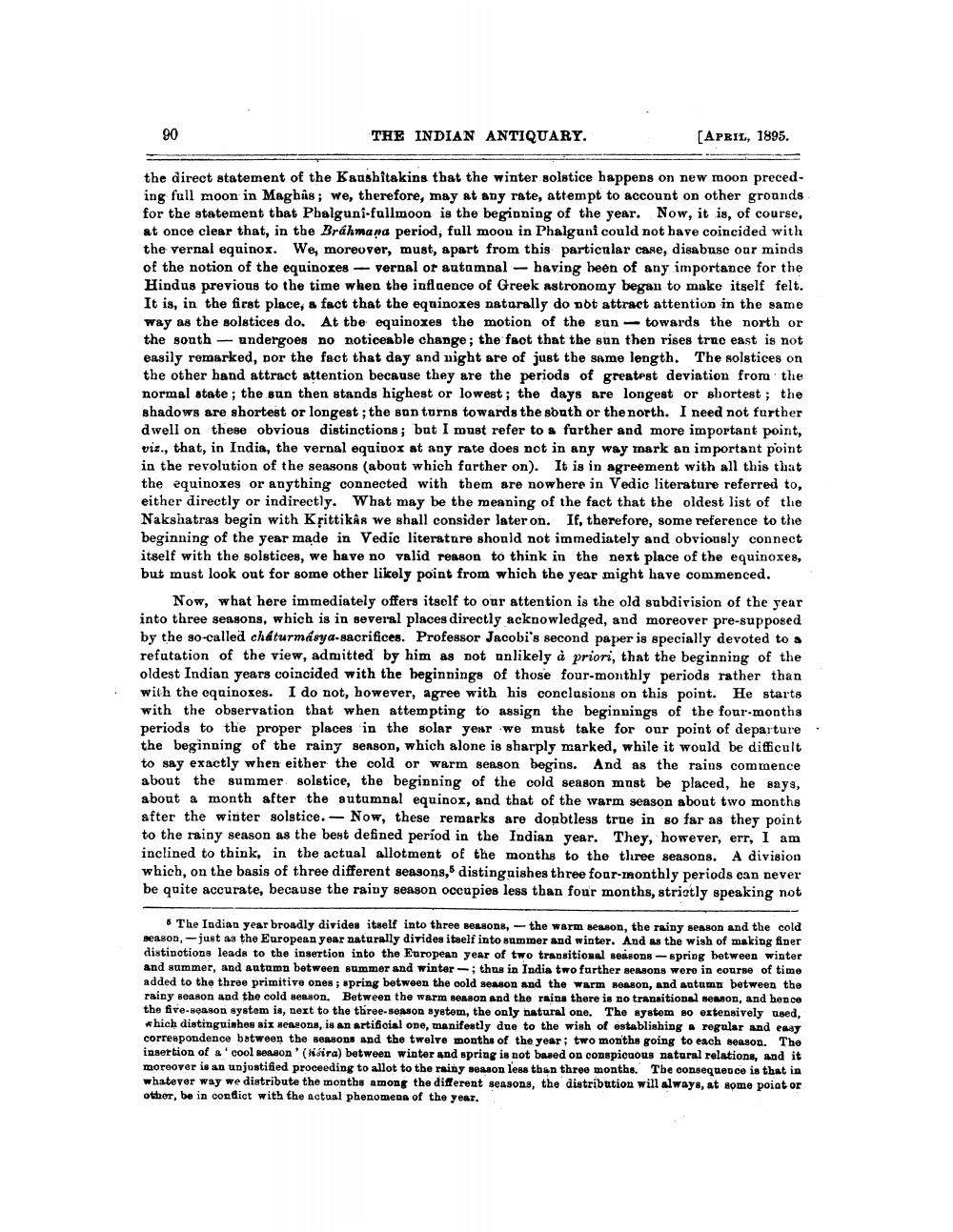________________
90
THE INDIAN ANTIQUARY.
[APRIL, 1895.
the direct statement of the Kaushitakins that the winter solstice happens on new moon preceding full moon in Maghûs; we, therefore, may at any rate, attempt to account on other grounds for the statement that Phalguni-fullmoon is the beginning of the year. Now, it is, of course, at once clear that, in the Brahmana period, full moon in Phalguni could not have coincided with the vernal equinox. We, moreover, must, apart from this particular case, disabuse our minds of the notion of the equinoxes vernal or autumnal - having been of any importance for the Hindus previous to the time when the influence of Greek astronomy began to make itself felt. It is, in the first place, a fact that the equinoxes naturally do not attract attention in the same way as the solstices do. At the equinoxes the motion of the eun. towards the north or the south undergoes no noticeable change; the fact that the sun then rises true east is not easily remarked, nor the fact that day and night are of just the same length. The solstices on the other hand attract attention because they are the periods of greatest deviation from the normal state; the sun then stands highest or lowest; the days are longest or shortest; the shadows are shortest or longest; the sun turns towards the south or the north. I need not further dwell on these obvious distinctions; but I must refer to a further and more important point, viz., that, in India, the vernal equinox at any rate does not in any way mark an important point in the revolution of the seasons (about which farther on). It is in agreement with all this that the equinoxes or anything connected with them are nowhere in Vedic literature referred to, either directly or indirectly. What may be the meaning of the fact that the oldest list of the Nakshatras begin with Krittikâs we shall consider later on. If, therefore, some reference to the beginning of the year made in Vedic literature should not immediately and obviously connect itself with the solstices, we have no valid reason to think in the next place of the equinoxes, but must look out for some other likely point from which the year might have commenced.
Now, what here immediately offers itself to our attention is the old subdivision of the year into three seasons, which is in several places directly acknowledged, and moreover pre-supposed by the so-called cháturmásya-sacrifices. Professor Jacobi's second paper is specially devoted to a refutation of the view, admitted by him as not unlikely à priori, that the beginning of the oldest Indian years coincided with the beginnings of those four-monthly periods rather than with the equinoxes. I do not, however, agree with his conclusions on this point. He starts with the observation that when attempting to assign the beginnings of the four-months periods to the proper places in the solar year we must take for our point of departure the beginning of the rainy season, which alone is sharply marked, while it would be difficult to say exactly when either the cold or warm season begins. And as the rains commence about the summer solstice, the beginning of the cold season must be placed, he says, about a month after the autumnal equinox, and that of the warm season about two months after the winter solstice. Now, these remarks are doubtless true in so far as they point to the rainy season as the best defined period in the Indian year. They, however, err, I am inclined to think, in the actual allotment of the months to the three seasons. A division which, on the basis of three different seasons, distinguishes three four-monthly periods can never be quite accurate, because the rainy season occupies less than four months, strictly speaking not
-
The Indian year broadly divides itself into three seasons, the warm season, the rainy season and the cold season, just as the European year naturally divides itself into summer and winter. And as the wish of making finer distinctions leads to the insertion into the European year of two transitional seasons-spring between winter and summer, and autumn between summer and winter -; thus in India two further seasons were in course of time added to the three primitive ones; spring between the cold season and the warm season, and autumn between the rainy season and the cold season. Between the warm season and the rains there is no transitional season, and hence the five-season system is, next to the three-season system, the only natural one. The system so extensively used, which distinguishes six seasons, is an artificial one, manifestly due to the wish of establishing a regular and easy correspondence between the seasons and the twelve months of the year; two months going to each season. The insertion of a cool season' (Hira) between winter and spring is not based on conspicuous natural relations, and it moreover is an unjustified proceeding to allot to the rainy season less than three months. The consequence is that in whatever way we distribute the months among the different seasons, the distribution will always, at some point or other, be in conflict with the actual phenomena of the year.




